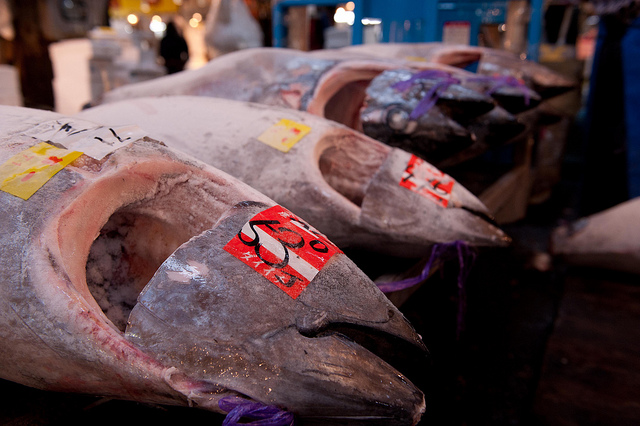
Photo by Flickr user Stewart Butterfield. CC BY-NC-ND 2.0
Japanese foodies are being confronted with the idea that the Pacific bluefin tuna is now threatened with extinction, according to International Union for Conservation of Nature (IUCN). The Pacific bluefin tuna was previously listed in the category of Least Concern about extinction.
The Switzerland-based IUCN recently added Pacific bluefin tuna to its Red List of endangered species. The announcement, as well as the plight of other fish stocks, has been met with shock by some Japanese netizens.
太平洋クロマグロ、絶滅危惧種に…国際自然保護連合のレッドリ… http://t.co/tGOuk22VxJ #まとめ pic.twitter.com/gknkkzaUXU
— 相沢 彩華 (@gbx9bwyv01gy1p) November 18, 2014
The Pacific bluefin tuna is now an endangered species and is now on the IUCN's Red List.
Another Twitter user reported:
絶滅危惧種:太平洋クロマグロを指定 IUCN http://t.co/ZuirAwncag “カラスフグは乱獲により過去40年で99.99%減った” ウナギ・マグロ・ニシンあたりは聞いてたけどふぐもかよ!ほんと資源管理って概念がないんだな
— Kelly@戦うヒロインゲー紅蜘蛛頒布中 (@kera_ma_go) November 18, 2014
Pacific bluefin tuna is now an endangered species, according to IUCN (http://t.co/ZuirAwncag), as is the Eyespot puffer (Takifugu chinensis) which has declined 99.99 percent over the past 40 years. I had heard about the eel, bluefin tuna, and herring, but now the puffer fish? It's like there is no concept of (sustainable) resource management.
The cause of the Pacific bluefin tuna's plight, according to the IUCN? Overfishing. The Pacific bluefin tuna accounts for about 70 percent of the world's bluefin catch. Immature fish (younger than three years old that have not had a chance to reproduce) account for 97 percent of the Pacific bluefin tuna catch.
Fisheries researcher Sumio Horikawa commented on the news:
IUCNのマグログループの議長のBruce Collette氏は「(主に日本が漁獲している)中西部太平洋で、稚魚の漁獲削減を含む漁業管理をしないと、短期的な資源状態の回復は望めない」とコメントをしているが、同感です。 http://t.co/sVSBHZopGp
— 勝川 俊雄 (@katukawa) November 17, 2014
Bruce Collete, head of the IUCN's Bluefin group, said that if [the Japanese] catch in the Western Pacific, notably of juvenile fish, is not reduced, in the short term Pacific bluefin stocks will not recover. I agree with his assessment.
While Japan consumes about a quarter of the world's tuna catch, bluefin tuna has been specifically targeted by the fishing industry for the sushi and sashimi markets all over east Asia.
Since the overwhelming majority of the bluefin tuna caught in the Pacific are juveniles that have not had a chance to reproduce, the population is estimated to have declined by 19 to 33 percent over the past 22 years.
Bluefin tuna is one of the most sought-after fish all over Japan. Despite pressures on worldwide stocks, there is, for the moment, plenty of fish to be found, and not just in high-class eateries:
800円でこの迫力!FIREBIRDの激安グルメ「マグロ盛り過ぎ丼」がヤバい▶http://t.co/SSqZlOMuOC pic.twitter.com/MmE9WwObNY
— Spotlight公式(スポットライト) (@misterspotlight) November 16, 2014
Look at the bargain you get for 800 JPY (US$8). FIREBIRD's super-cheap gourmet Bluefin tuna super donburi tuna rice bowl is the best.
- Spotlight LLC (@misterspotlight)
Bluefin tuna became a popular staple following the Second World War, when great efforts were made to find food to feed a hungry population. The fish is now firmly entrenched in Japanese cuisine:
今日は静岡の潮見坂道の駅に来ています。 やっぱり海は良い! マグロの串焼きが売っていたので食べました。 マグロのお頭焼きヤバイ!笑 In Shiomisaka/Shizuoka I ate a tuna grilled pic.twitter.com/wZzBPI44XA
— ToMo (@dear3ToMo) November 16, 2014
We drove to the beach at Shiomisaka, Shizuoka. And of course, the sea is the place to be! We ate barbeque bluefin tuna skewers, and grilled a tuna head whole. LOL.
Much of Japan's longline tuna fleet is based in Kesennuma, Miyagi Prefecture. Kesennuma is a small, isolated town on the Pacific Coast that was devastated by the 2011 earthquake and tsunami. In an effort to revitalize the stricken city, the central government has pumped money into the Kesennuma's fishing industry, and the city is once again working at selling fish to consumers eager for a taste of fresh fish, and not just bluefin tuna:
気仙沼生メカジキが美味しい季節!通販で!気仙沼は三陸のブランド!東北ではこのメカジキ刺身はマグロ以上のご馳走!癖も無く脂のって旨い!画像通りの物を気仙沼Aランクを直送します。是非ご覧下さいhttp://t.co/92CEvHsk91 pic.twitter.com/w9xLzEnJTm
— 東北うまいもの市場 (@tohoku_u_ichiba) November 16, 2014
Once again it's the season for delicious swordfish from Kesennuma and Sanriku coast, available for mail order. In Tohoku swordfish sashimi is prized even more than bluefin tuna. The fatty flesh is delicious. Just like in the picture, grade A Kesennuma swordfish will be delivered straight to you!
Tuna and swordfish are large predators that are slow to reproduce, and typically range the world's oceans in search of food and in order to reproduce. Their migratory paths across the high seas make this popular species of fish difficult to manage.
The southern bluefin tuna, a distinct species of bluefin tuna that breeds in the Indian Ocean, is listed as critically endangered on the IUCN Red List of threatened species, and catches these days are about 80 percent of historical totals.
On a more positive note, the Atlantic bluefin tuna population is recovering after a disastrous decade that resulted in drastically lowered quotas. In 2013, the bluefin tuna spawning stock in the East Atlantic and Mediterranean reached nearly double the levels of the 1950s, according to an ICCAT estimate. As a result, in November 2014 some nations increased their quotas of Atlantic bluefin tuna, a move that is controversial.







1 comment